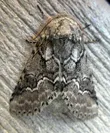
Harmful Effects of Lesser Puss Moth
A species of Cerura
Lesser Puss Moth poses risks to poplar and willow plants by chewing on leaves, causing tissue loss and potential defoliation. This impairs photosynthesis and can stunt plant growth.
What Type of Pest Is Lesser Puss Moth?





AI entomologist in your pocket
Scan QR code to download

